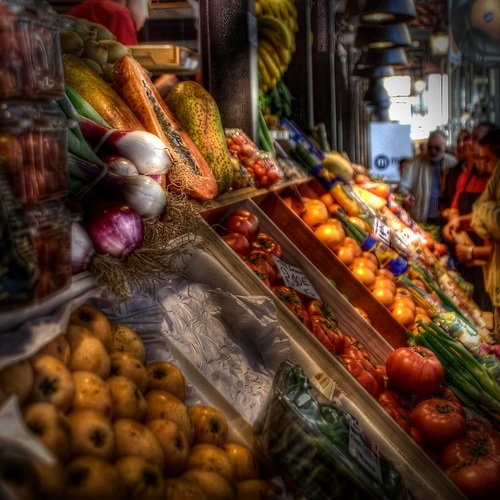Shopping - Lesson 2 - Conversation:
Enun Mercado al Aire Libre
(Inan Open-Air Market)
(photoby
Dorli Photography usedunder terms
of Creative Commons license.)

|
Kathy: |
¿Cuántoquiere
por esa mantelería? |
How much do you want for
thattable linen set? |
|
Vendedora: |
Dos
milquinientas pesetas. |
Two thousand five hundredpesetas. |
|
Kathy: |
¿Por
quétan cara? |
Why so expensive? |
|
Vendedora: |
Está
hechaa mano. Además tiene doce servilletas. |
It is handmade. Besides, it
hastwelve napkins. |
|
Kathy: |
Me la
dejaen dos mil, ¿no? |
You will let me have it for
twothousand, won't you? |
|
Vendedora: |
No
puedeser, señora; pero mire, esta otro vale dos mil. Es un poco más
pequeña. |
It cannot be, ma'am. But
look,this other one costs two thousand. It's a little smaller. |
|
Kathy: |
Está
bien.Y ¿cuánto vale ese cántaro? |
All right. And, how much
doesthat pitcher cost? |
|
Vendedora: |
Seiscientascincuenta.
Es de Talavera. |
Six hundred and fifty. It's
fromTalavera. |
|
Kathy: |
¿No mehace
una rebajita? |
Won't you give me a
smalldiscount? |
|
Vendedora: |
Bueno,lléveselo
por seiscientas. |
OK. Take it for six hundred. |
|
Kathy: |
Está
bien.Entonces me llevo la mantelería y el cántaro. |
OK. Then I will take the
tablelinen set and the pitcher. |
Notes on conversation
Streetmarkets
as well as outdoorfood markets can be found in every Spanish city or
town. Open once aweek,street markets display a large variety of items,
among whichembroidered linensand pottery are some of the favorites. You
may bargain in streetmarkets. Neverin stores.
Me la deja.
Literally"Leave me it."
Es de Talavera. "[It]
isfrom Talavera." Talavera is the name of a Spanishcity famous for its
artistic ceramics.
¿Nome
hace una rebajita?"Won'tyoumake
me a small dis-
count?
Lléveselo. "Take
itwith you." se ("to you") is used insteadof le
when followed by lo, la,or le.